
Planting the Understory

Contributor
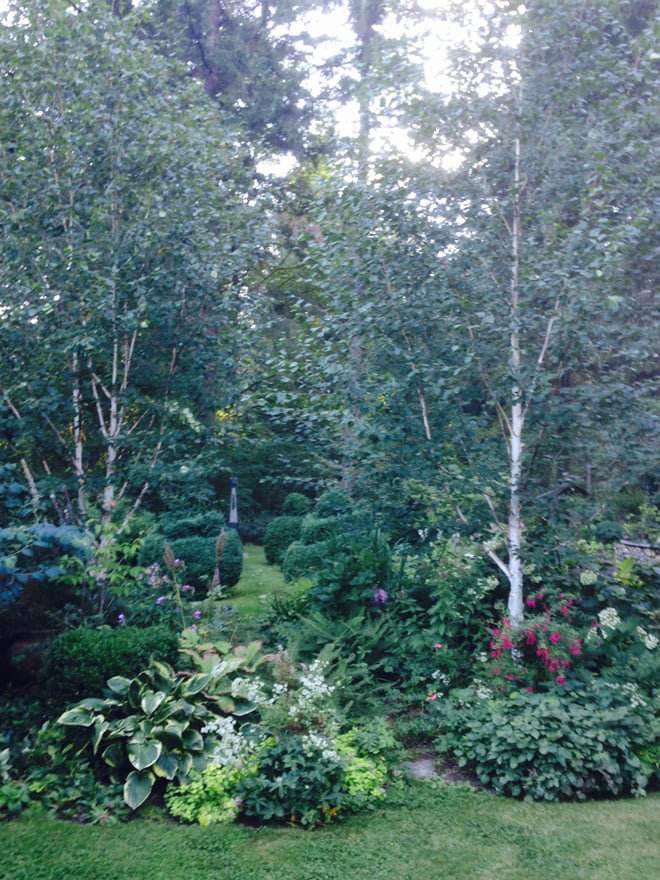
I have learned to create layers in the garden. Not only does this make the garden more interesting but it also encourages habitat for birds, insects, and animals. Here in my Northwest garden I have about six layers: tall trees, understory trees, large shrubs, small shrubs, perennials, and ground covers.
My garden is filled with native trees—Douglas fir (Pseudotsuga menziesii), Western red cedar (Thuya plicata), and big leaf maples (Acer macrophyllum). The large conifers are more than 100-feet tall and the maple are around 60-feet tall, creating a tall overhead canopy but leaving a lot of space between the big trees and the ground. So, as I was building my garden, I concentrated on the understory, that layer of trees ranging from 20 to 40 feet.
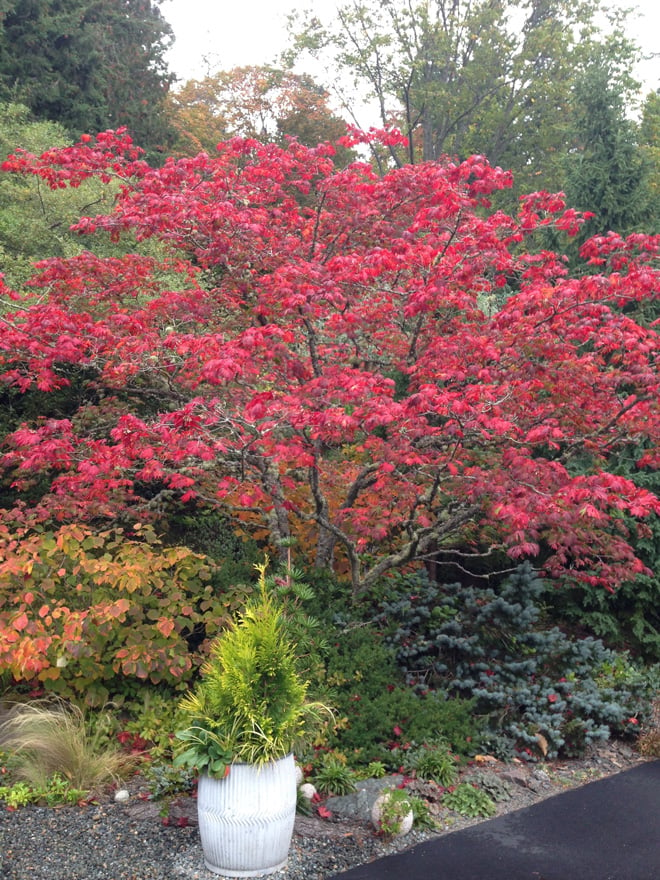
For more than a dozen years I worked at the Miller Botanical Garden in Seattle, one of the best woodland gardens around. Mrs. Miller, the garden’s original owner and gardener, focused on fall—her favorite season—in the garden by including trees with good fall color. Working there gave me the opportunity to see what trees did well in northwest woodland conditions like those in my garden.
My goal was to create an in-between layer of trees that would enhance the taller canopy. Many of the trees I was considering naturally grew at the edge of the woods and so would tolerate part shade. This made them ideal for growing amongst the existing firs. I began by clearing about a dozen big leaf maple seedlings—a fast growing but short-lived tree that would have made the garden too shady.
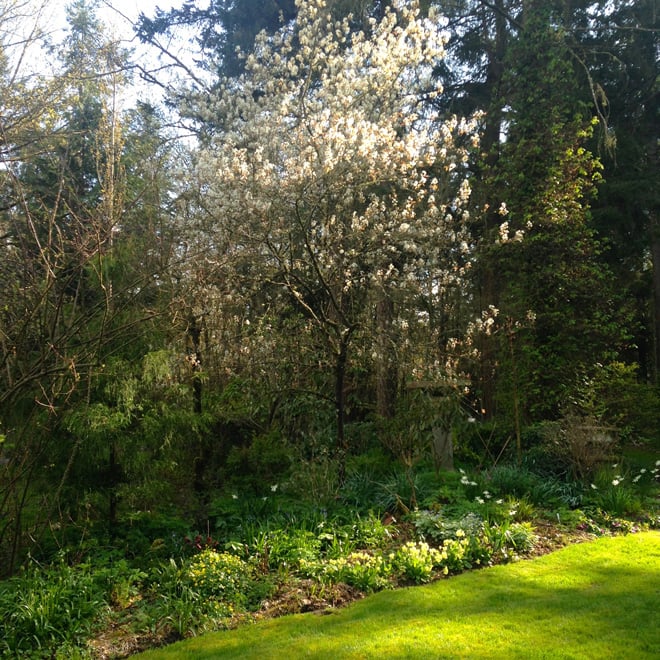
Also, as a plant collector I saw this as an opportunity to add a number of different types of trees to the garden; a luxury that I never had in my former city garden. I was fortunate that my new garden already contained several nice small trees, including a serviceberry (Amelanchier ×grandiflora), a small tree with a profusion of white blooms in spring and wonderful fall color. Planted not far from the serviceberry was a spindle tree, (Euonymus sachalinensis). The Euonymus produces nice white flowers in spring and showy seedpods that look like little orange and red parachutes ripen in late summer followed by excellent fall color.

Where I had removed many of the maple seedlings I started to add some of my favorites from the Miller Garden. The first was a Dogwood, (Cornus alternifolia ‘Gold Bullion’). This small tree, to 10 feet in 10 years, sports bright chartreuse leaves in spring followed by white summer flowers and yellow fall color. Next in line was a very textural plant. Big leaf magnolia (Magnolia macrophylla) grows to about 35 feet with very large leaves that are up to 24 inches long and 12 inches wide; in fall the paper-thin leaves turn brown and the veins are exposed. The third tree I planted in this section of the garden was a sourwood (Oxydendrum arboreum) with bright red leaves in fall. Sourwood blooms late in the season so often displays its chartreuse flowers clusters along with the red foliage.
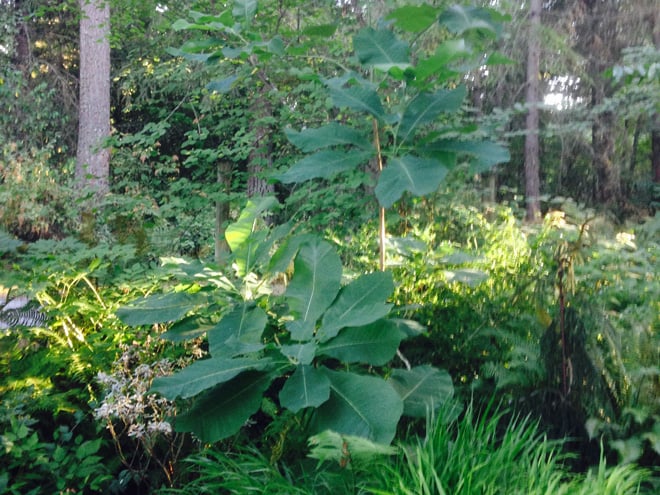
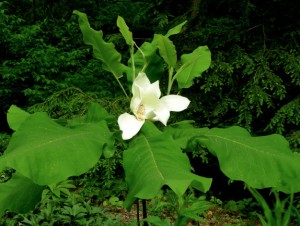
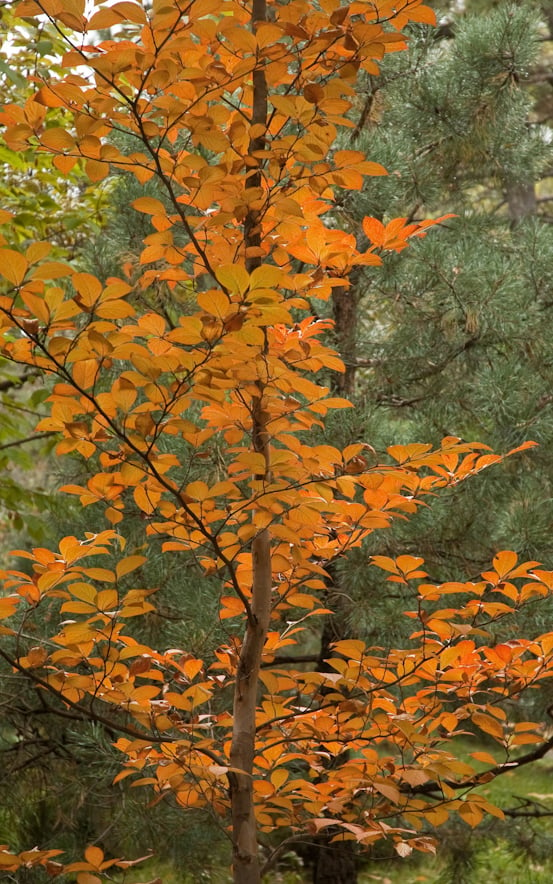
Further along this same bed I planted a Japanese snowbell tree (Styrax japonica ‘Pink Chimes’) that in early summer is covered with small pink bell shaped flowers in early summer follow by good yellow fall color. Located just outside my living room window it provides a beautiful focal point. Directly behind it is a stand of the native vine maple (Acer circinatum), which also get good fall color.
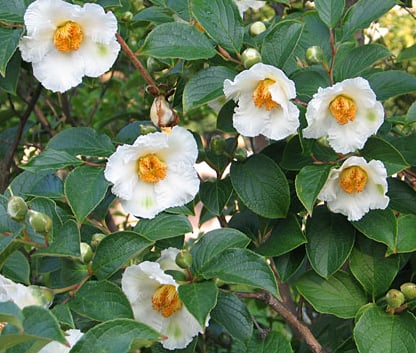
I completely cleared a little courtyard garden except for a hazelnut, (Corylus cornuta) before planting a Japanese stewartia (Stewartia pseudocamellia) one of my favorite four season trees. This tree has coppery new growth, white camellia like flowers in summer, the best fall color of any tree in my garden—red, orange and yellow—and peeling bark for winter interest. In addition to the stewartia, I planted a paper bark maple (Acer griseum) for its peeling bark and good fall color, and a Parrotiopsis jacquemontii, an unusual small tree similar to a Parrotia but smaller in stature. Just to round out this corner of the garden I added three more Japanese maples with summer green leaves and red to orange fall color. Most of our native deciduous trees are yellow in fall, so whenever possible I try and add red or orange fall color as a contrast.
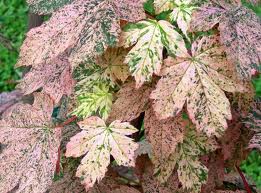
To screen the road in front of our house I planted another sourwood, two more Japanese maples, and two stripe bark maples (Acer tegmentosum). The white stripe bark on Acer tegmentosum is a real eye catcher year round. Further along the fence line and close to the driveway I wanted a showy specimen tree so I planted an Eskimo sunset maple (Acer pseudoplatanus ‘Esk Sunset’) with showy leaves that are cream, pink, and green on top and purple on the underside.
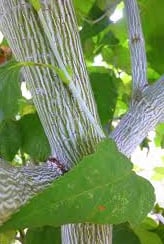
An ice storm three years ago brought down a couple of big trees in the middle of the garden, making room for me to I add even more small trees, including two stunning Japanese maples. Acer japonicum ‘Attaryi’ has larger leaves and turns orange in fall; the warty bark maple (Acer palmatum ‘Arakawa’) also has a reddish orange fall colored maple and a very warty texture to the trunk which makes it interesting year round. Not far from this same area and very visible from the house I planted a grouping of three paper bark birches (Betula jacquemontii) with white trunks that look great in winter.
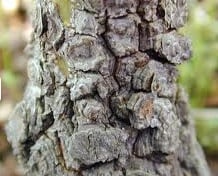
Not many people have the chance to plant a couple dozen trees in their garden. I feel fortunate to have had the opportunity to know these trees before I planted them. Some of the new trees have been in the garden for almost ten years now and are well established, no longer looking like new introductions. The birds and bees are happy and so am I. In my minds eye they look even better, a little further down the road.
Old Goat Farm Garden & Nursery offers well-grown plants that are also showcased in the garden. Owners Greg Graves and Gary Waller are plant enthusiasts and a little something for everyone. Old Goat Farm is open the first weekend of the month April through October and by appointment for garden tours and special events.











Responses